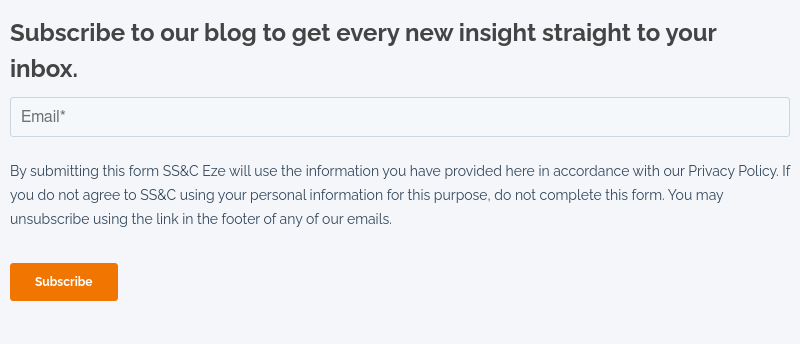In the last few years, multiple new platforms have popped up on the market claiming to deliver cloud-based, fully integrated front-to-back investment management software, fund services, and data. Some of them offer relatively simple, out-of-the-box functionality that may provide a seemingly good starter kit for funds, at a cheap price point.
Fast, cheap, complete – all good, right? Well, not exactly. Before you go diving for the cheapest solution out there, consider whether your choice offers these must-haves:
Strong Order Management
As the critical central hub of your investment activity, the order management functionality must be advanced and flexible. If the trade origination process is clunky and inefficient, you probably don’t want to be dealing with it day in and day out—and user acceptance will be limited, resulting in a workflow that is out of compliance. Some systems have rudimentary, cumbersome trading functionality, limited allocations, and inefficient workflows. You need advanced modeling functionality, flexibility with allocations, and advanced compliance built into your engine from the start to stand out and meet investor expectations.

Connecting the Entire Operation
In today’s world, integrated execution and order management is a must. Maintaining separate systems for execution and order management can lead to inefficient trade execution because traders have to swivel back and forth between the OMS to check compliance and the EMS to execute trades. Your system needs to offer truly integrated advanced compliance and execution, backed by the same code, to function most efficiently.
Many systems have claimed to be delivering their execution and order management under one roof, as the market has responded to the growing need for EMS/OMS consolidation. Not all systems deliver this integration in a seamless manner. In fact, Eze Investment Suite is the only vendor in the market that delivers fully integrated trading and compliance functionality enabling investment managers to perform compliance checks on a pre-trade basis seamlessly within the same execution screen.
Moreover, managers should ensure that there is flexibility to integrate with third-party EMS providers, should you need them. As a front-to-back provider, we’re the first to point out the advantages of a fully integrated front-to-back investment management solution, but we also know that some of our clients’ strategies are best suited by a third-party EMS. This is why Eze has the flexibility to integrate with third-party EMS platforms quickly and easily.
Last but not least, it’s important to have built-in shadow NAV, reconciliation, and reporting functionality. The more efficiently your system can incorporate these important tasks into its daily workflow, the more time your team will have to devote to investment-related tasks.
System Flexibility
If you need to adjust your trading screens to suit your workflows, and the solution you’re considering doesn’t accommodate such customization, it’s time to look elsewhere. You want a system that will be flexible enough to accommodate new investment strategies, asset classes, fund types, and other scenarios as you add them—you don’t want to have to do custom work on the system every time you expand your book of business.
Trusted & Proven
More and more investors want to see their investment managers using systems that are backed by experienced providers. When you choose a software that’s still in early stages of development, you put your fund at risk of experiencing delays in functionality you need. Moreover, given the rapid pace of change in the regulatory environment, you need a provider that’s well-versed in implementing large-scale changes to the system quickly.
For instance, during MiFID II implementation, SS&C Eze created a MiFID II working group and shifted around priorities to ensure all clients could meet multiple requirements under the regulation before the deadline. Smaller providers may not have the institutional infrastructure in place to shore up resources for regulation-specific development and support in times of need.
Moreover, SS&C Eze works closely with asset allocators to understand their needs and what capabilities they expect their asset managers to have. Based on these conversations, we’ve added value that has allowed many of our clients to raise funds and continue to satisfy their investors’ requirements well after implementation. You should expect the same level of due diligence from your technology vendors.
Strong Support Model
We’ve seen multiple clients come to us from smaller providers this year, frustrated by what they termed a “set-it-and-forget-it” mentality. They’ve cited limited resources available and difficulty in getting a hold of their providers post-implementation. We firmly believe your vendor should be more than a vendor – you should have a partner for your investment operation. This means getting dedicated support from implementation throughout the life of your relationship. This means a dedicated team to take your questions, someone to work with you on your goals and aspirations, and a responsive task force that will work with you on any issues you may encounter. That means software updates that aren’t disruptive, a rapid development cycle that releases features in an agile fashion, and flexibility around your needs.
This doesn’t just extend to the buy-side. We work closely with our sell-side partners to ensure our platforms stay current with all of the tools and resources they have to offer. This, in turn, ensures that our buy-side clients can get access to the latest tools available.
Affordable Total Cost of Ownership
You may be getting pitched by systems that are cheap on paper. But there is a difference between price and total cost of ownership. We at Eze firmly believe that most funds are best suited by a model that scales: we charge by the number of users, and scale based on the size of the investment management operation, not assets under management. This makes our system affordable to both emerging and established funds. Moreover, we have our own market data source that allows you to avoid spending more on third-party data. There are no extra terminal requirements, and we easily integrate with third-party systems should you need them.
Lastly, consider in your cost calculation the future of your fund. Most system switches are at the very least disruptive to your fund, and if you find that your current system isn’t built to grow with you, you may be looking at a future filled with upgrades. All that work costs time, and, in the end, money. By choosing a system that’s flexible and scalable, you will be saving yourself money in the long-run.
To find an Eze solution that works for you, click here. To learn more about what’s happening at SS&C Eze, subscribe to our blog.

